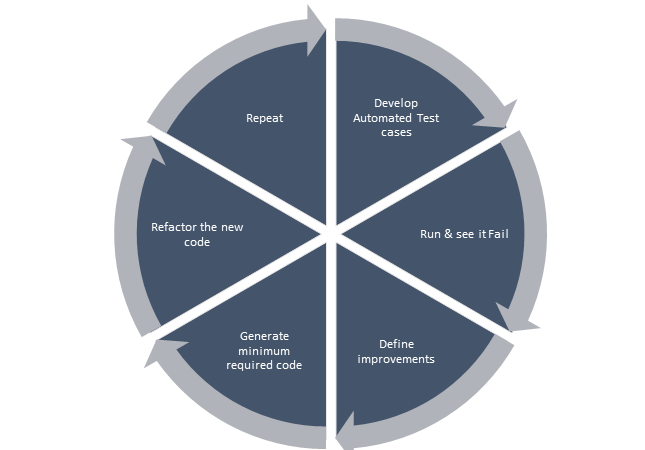5 More Best practices for Test Driven Development (TDD)
Test Driven Development (TDD) is a testing methodology that helps achieve Speed and Quality with its specifically structured mechanisms. In 2015 we published a blog post on 7 Best Practices for Agile Test Driven Development (TDD). The blog post was hugely appreciated, liked and shared and got over 80,000 hits.
In this post, we take that further and discuss 5 More Best Practices to derive maximum results from TDD.
Businesses, small-medium-large, are constantly trying to reduce their costs and at the same time race up to the market. Software Testing approaches and methodologies are being designed increasingly to address both objectives – Speed and Quality.
Over a period of time, software testing for business critical software and applications is being increasingly outsourced. Reasons are pretty evident – leveraging expertise, cutting down time to market, spike up productivity, cost-effectiveness, and improved code quality.
Building a robust and resilient software/application is getting more and more critical, as most virtual interfaces offer new customers and opportunities. The software/application further links and interacts with third party applications that help deliver desired customer experience. For instance, Banking/Financial applications have numerous offshoots to complete the necessary transactions.
Most importantly, getting third party expertise on board gives practical insights into the code’s quality and provides an undoubted proof that the code works as intended.
While these reasons remain true for outsourcing any type of software testing, it holds true for Test Driven Development (TDD) as well, considering that any form or type of approach has to help serve the business-critical objectives.
Investments are high and risks are equally high, so getting the best approach that enables agility and speed is critical.
Why consider Test Driven Development?
Before we understand various related aspects, let’s get the macro perspective. The core objective behind considering TDD is to build smaller test cycles and bring more agility in the process.
With TDD you start by scripting the test cases for a new functionality, followed by production code required to pass the test, post that you refactor the code to increase its sustainability.
It is a technique adopted both for designing the software and testing it. The automated Unit tests are written before the code in this approach, which enables you to get fast confirmation on whether the code behaves as expected.
TDD is a development process that establishes its finding/assessments on recurrence of a short development cycle, where the developer writes automated test cases that would further define improvements or new functions and then produce minimum required code to pass the test and ultimately refactor the new code to the required/improved standards.
The way TDD works, presents its approach and objective too.
The objective is to have shorter test cycles – introduce a new test, execute all tests, look out for failures, generate a code, execute the test again, refactor the code basis the results, and then repeat the process.
Some key reasons for considering TDD are:
- Reduce development costs
- Cut down time to market in the development process
- Improve programmer’s productivity
- Develop a neat code that is well-defined
- Cut down turnaround time
- Generates proof that the developed code works as expected
- Boosts the process of generating quality code
Breakthrough development processes like TDD need some assured best practices.
- Prepare a road-map of tests
Test-first approach helps you to validate the created tests with ease. With the red-green refactor routine, first step is to create a ‘red’ test and ensure that all problems related to the code are exposed.
Test-first approach enables sketching the thoughts and then breaking it down into test cases. So, while considering the Test driven approach it is recommended to sketch out a roadmap of tests and get an idea of the approach. It is specifically applicable and relevant for an approach, where constant distractions are expected.
- Spell out the rules
After the standards/rules are set, it helps organize the tests in a more logical pattern and make the testing tools align with these rules/conventions. Additionally, it is important to ensure that everyone in the team knows about the conventions implemented and is in sync with it.
Apart from this, more popular conventions are implemented to help the new members on boarding the project. It will help them to get to speed and leverage the existing knowledge.
- Treat implementation separately
It is a common practice to have two source directories – for Implementation and Testing. The number of source directories for bigger projects can increase, but separation must be maintained between implementation and test codes.
The obvious benefit is that it reduces the chances of accidentally packaging tests with production binaries.
- Similarly name test classes
It is a commonly implemented practice to name test classes similar to implementation classes with changes in the suffix. For instance, if the implementation class is magicmix, then the test class should be magicmixtest.
Additionally, in order to help identify methods that are tested, test classes can be separated by the function. For instance, if the test class has add or remove option, it can read as magicmixAddTest and magicmixRemoveTest.
The basic benefit is to identify and locate the tests within the entire maze.
- Write a new code only when the test fails
TDD involves generation of tests constantly and within short cycles. If the initial tests are successfully running without any failures and there is no need to rewrite, then either the functionality already exists or there is some defect with the test.
In this approach, the tests are expected to fail so that verifications and amendments are done to the implementation code. This helps confirm that the test is not effective without implementation.
If implemented consistently with the right approach, TDD can significantly reduce the number of defects. It can further cut down additional efforts in the overall development process, as it helps fix issues faster and retest defects rigorously.
Ultimately it helps in improving the overall code design, thanks to shorter test and development cycles, enabling faster time-to-market.
Cigniti experts collaborate with acclaimed and innovative enterprises to develop and implement an appropriate testing strategy as per their requirements and specifications. Our Testing Center of Excellence (TCoE) Services have been consistently delivering the needs of enterprises and ISVs across various verticals.
Connect with our experts to devise a test strategy that enables not just faster turnaround time, but offers agility to restructure your tests and enhance value.






Comment (1)
Excellent Article!
Thanks for Sharing!
https://uploads.disquscdn.com/images/97acb721df42bfd4e2895e0c20a648625400d87e716cc44a97b445b13bf1e413.jpg